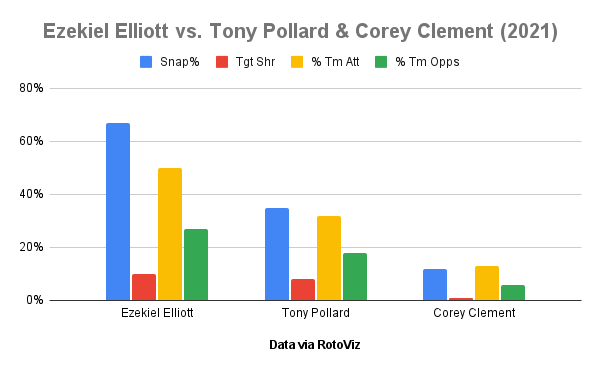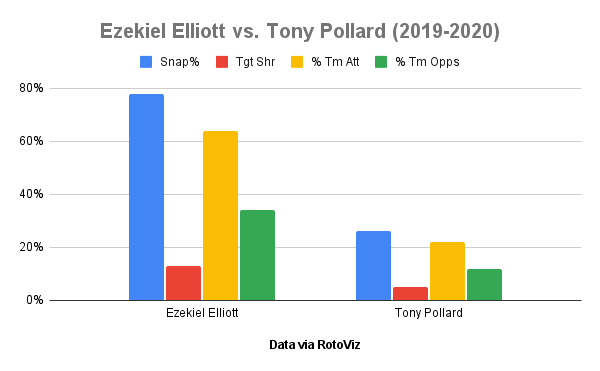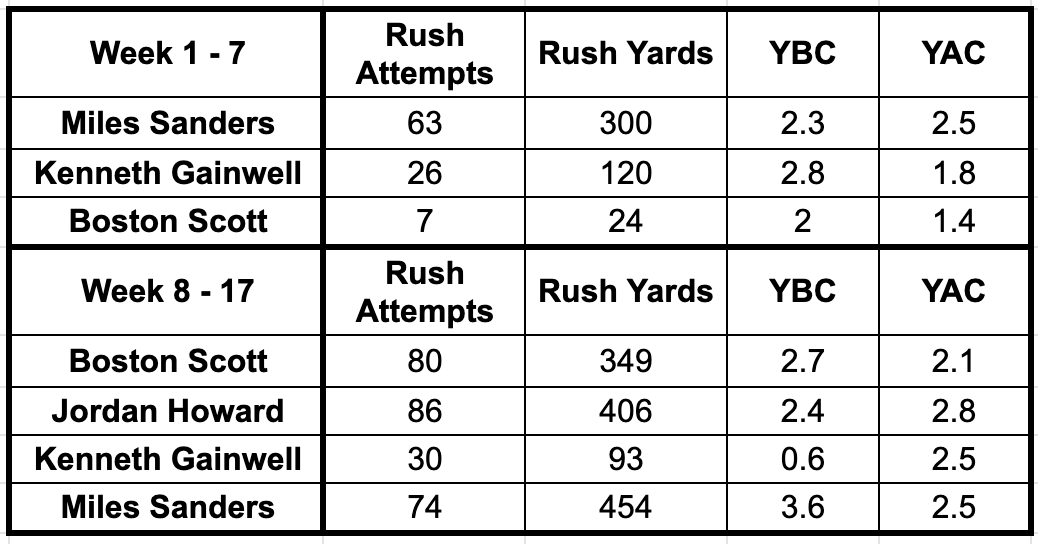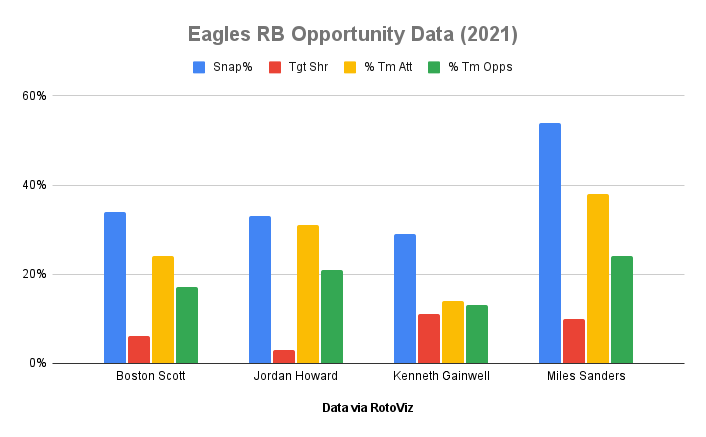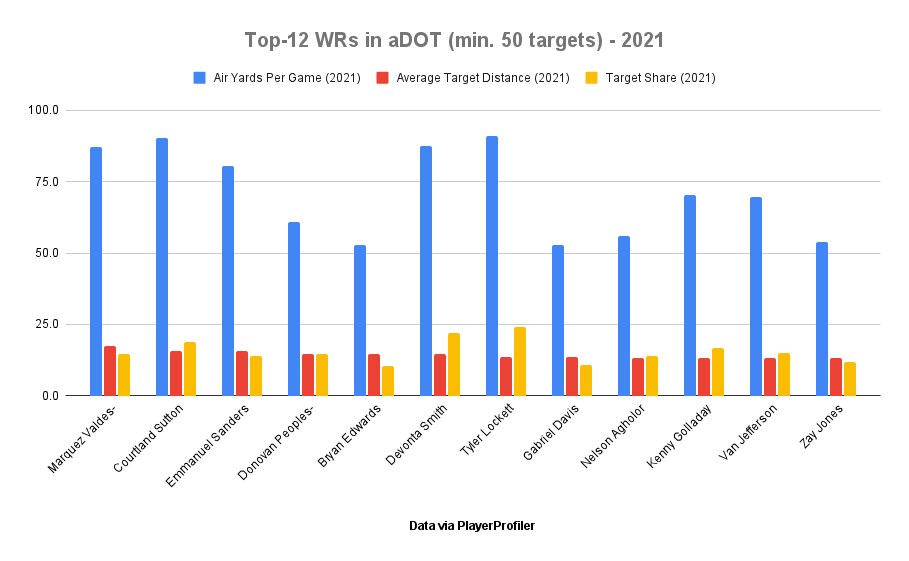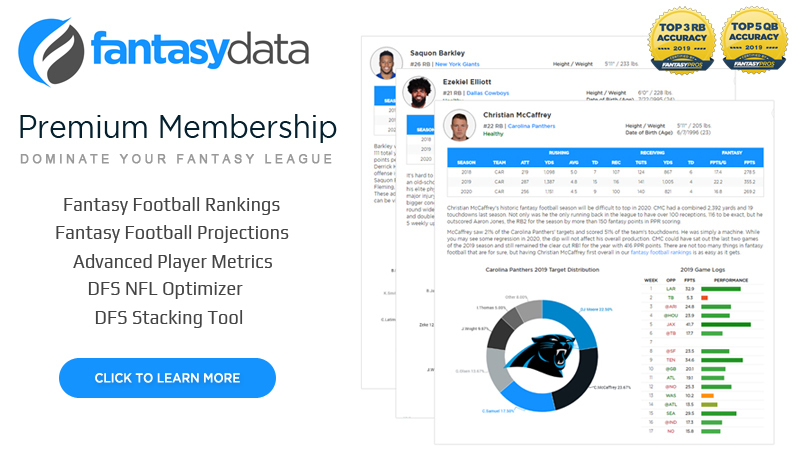Fantasy Football Draft Strategy
Crossing names off our draft list limits the player pool for positive or negative reasons. Fantasy Football is a weekly game, and we experience unpredictability in fantasy football when an unexpected player splashes or struggles. It’s early, and these data-focused opinions could change throughout the offseason. However, let’s look at five players to consider avoiding at their ADP. Context matters and I’ll also lay out the path for upside since that often lingers in my mind.
Ezekiel Elliott (RB, DAL)
Underdog ADP: 39, RB17
Throughout Ezekiel Elliott‘s career, he posted top-10 opportunity shares with a career-low of 57.7% (No. 20) in 2021. Elliott’s allure involved his durability, though chest/rib and knee injuries in 2021 impacted his performance. Although Elliott shared opportunities with Tony Pollard, he played in all 17 games with 244.3 Weighted Opportunities (No. 6) on a Cowboys team that ranked eighth with 27.6 Team Run Plays Per Game.
Elliott finished as RB15 with 14.8 PPR/G, nearly identical to the 15.1 expected fantasy points per game (No. 15). The early Underdog ADP as RB17 seems reasonable, but should we take the plunge in the dreaded running back dead zone? In Week 9, Elliott dealt with a right knee contusion, then was diagnosed with a partially torn PCL two weeks later. However, reports indicate Elliott had a torn PCL since Week 4.
Elliott’s total yardage, carries, routes, and targets slowly trended down throughout the season, aligning with the injury issues. With that trend, Tony Pollard and other backs ate into the team’s running back opportunities. From 2019 to 2020, Elliott garnered 64% of team rush attempts and 13% target share versus Pollard’s 22% rush attempts and 5% target share.
Then in 2021, Elliott’s team rush attempts dropped to 50% with a 10% target share, with Pollard’s workload increasing to 32% of the team rush attempts and 8% target share. Corey Clement mixed in too, but Elliott’s decreasing opportunities remain notable.
Elliott still garnered a high amount of High-Value Touches with 64 (No. 21) and 57% of the team’s HVT (No. 27). It feels weird to fade a running back with that type of volume, especially with Elliott’s consistency. However, he probably keeps a steady workload to begin 2022. Of course, Elliott’s path for upside involves the heavy workload, touchdowns, and enough passing opportunity to foster an RB1 season. I’d rather be a year early than a year late, and I’m avoiding Elliott at his early 2022 ADP, though Dr. Edwin Porras’ recent podcast has me having second thoughts.
Allen Robinson (WR, LAR)
Underdog ADP: 47.9, WR22
From one volume-based player to another, let’s discuss Allen Robinson. After a top-12 target share in 2019 and 2020, Robinson’s target share dropped to 19.2% (No. 41). Unfortunately, Robinson played on a struggling Bears squad with 31.8 Team Pass Plays Per Game (No. 23), with rookie Justin Fields taking over the reins to finish the season.
Robinson lacked efficiency in past seasons, with 2.19 yards per route run (No. 30) in 2019 and 2.06 YPRR (No. 24) in 2020. With the offensive inefficiencies and low passing volume, Robinson posted a 1.42 YPRR (No. 76) in 2021. Now paired with one of the most efficient passers in the league in Matthew Stafford, evidenced by the 7.8 Adjusted Yards Per Attempt (No. 3) in 2021, Robinson’s efficiency should increase. Possibly, but Cooper Kupp’s 32% target share (2021) would need to dip to 22-24% like in 2019 and 2020 for Robinson’s volume to trend back near his 2019 and 2020 numbers.
The team context and projection have boosted Robinson’s ADP as a WR2 in Underdog ADP. Since I don’t think Stafford will replicate his 2021 numbers, I’m also expecting Kupp’s numbers to regress, though Kupp will still have a WR1-type opportunity. Robinson’s path for upside includes improved efficiency connected to Stafford via YPRR, YPT, or touchdowns. The Rams’ offense has shown the ability to boost multiple receivers as a WR2 with WR1 upside, so we could see that happen with Robinson in 2022.
Gabriel Davis (WR, BUF)
Underdog ADP: 47.9, WR23
One of the hotter names on Twitter over the past few weeks involves Gabriel Davis. On the season, Davis averaged 7.9 PPR/G (No. 60), which increased to 13.1 PPR/G from Week 13 to 18, not including his 201 receiving yards and four touchdowns in the AFC playoff game versus Kansas City.
With Cole Beasley gone and the addition of Jamison Crowder and James Cook in the NFL Draft, Davis’ ADP jumped to an Underdog ADP around the top-50 as WR23 near Lamar Jackson, David Montgomery, D.K. Metcalf, and Allen Robinson. We’ve at least seen several players in that range prove it in the past, so the ADP feels rich as it bakes in a projected jump.
I’m late to the Gabriel Davis discussion.
📷#1 – Using the @RotoViz Screener, the 1st image includes the Year 1 & 2 closest comps to Davis including reEP, reFPOE, reTRGS, PPR, & DRAFT.
📷#2 – Since several of the WRs didn’t play a third year, the Year 3 list dwindles to 3. pic.twitter.com/3S1Q2Wc0T0
— Corbin (@corbin_young21) July 6, 2022
From 2010 to 2021, I looked at top comparisons with Davis in Year 1 and Year 2 based on their receiving EP and FPOE, targets per game, PPR, and the player’s overall draft pick. Several of the top comparisons include Malcolm Mitchell, Kenny Stills, Donovan Peoples-Jones, and Quintez Cephus. Since a few didn’t play in their third season, we narrow down the Year 3 comparisons to Mecole Hardman, Stills, and Jarius Wright. With Hardman (7.8 PPR/G) and Wright (8.0 PPR/G) as notable names, Davis doesn’t have a positive comp.
What History Says About Gabriel Davis@RotoViz Range of Outcomes tool found 50 players with most similar prior seasons
Only 3/50 players (6%) scored at least 7.5 PPR/G more in n+1 season
Given his 7.9 PPR/G avg in 2021 — Davis would need to be a 6% outlier to justify ADP pic.twitter.com/TqUPYgOeuN
— Curtis Patrick 🥇 (@CPatrickNFL) July 6, 2022
The path for upside involves Davis garnering a target share of 20% or higher like Cole Beasley earned in 2021 or some touchdown efficiency with a 15-20% target share similar to Dawson Knox last season. To keep it simple, we want offensive pieces on good offenses, so I’m admittedly concerned about avoiding Davis at his ADP, though that might change as the season inches closer.
Miles Sanders (RB, PHI)
Underdog ADP: 77.2, RB26
Last season, the Eagles finished with a run-heavy approach partly due to concerns around Jalen Hurts’ passing ability. The Eagles relied on two to three backs per week, including Jordan Howard, Miles Sanders, Kenneth Gainwell, and Boston Scott.
While Miles Sanders took a healthy chunk of the rushing attempts and yards, Howard and Scott ate into the rushing workload. Gainwell flashed the receiving upside with four weeks of RB1 receiving EP of 11.4/G, aligning with when he garnered five targets or more. Often, rushing quarterbacks can negatively impact their surrounding pass-catchers, which means Hurts’ consistency as a passer might not be as fruitful for the pass-catchers.
Sanders received three targets in five of the first six games in 2021, so there’s a chance that could occur again in 2022. However, drafting a running back in Sanders that’ll likely share with two to three other backs seems like a hard pass in the RB dead zone.
Last season, the Eagles finished the second-highest Rush% (49%) in neutral game scripts behind the Patriots. Without neutral game scripts, the Eagles ranked first in Rush%. The Eagles’ Pass% and Rush% likely regress after extreme outliers in the first and second half of the season, which means less total workload and smaller pieces of the pie for Sanders.
The path for upside with Sanders involves one or two injuries to backs on their team, massive touchdown regression, or a heavier workload than expected. If anything, grab Gainwell about 70 picks later since he possesses the receiving upside with the rushing ability at a much cheaper cost.
Marquez Valdes-Scantling (WR, KC)
Underdog ADP: 98.8, WR47
Like the Packers, the Chiefs have a clear downgrade at receiver in 2022. The Chiefs added JuJu Smith-Schuster, Marquez Valdes-Scantling, and 2022 rookie Skyy Moore to their receiving core. They also added a polarizing back in Ronald Jones as the core of their offense, outside of the centerpiece in Travis Kelce.
The narrative surrounding Valdes-Scantling or the Packers’ WR2 – we want a piece of their offense tied to Aaron Rodgers. Unfortunately, Valdes-Scantling, Allen Lazard, or other supplemental options haven’t provided consistency. Valdes-Scantling has been a regular atop the aDOT leaderboards with 17.5 (No. 1) in 2020 and 2021 and 15.8 (No. 5) in 2019. Outside of that, he lacked efficiency with the limited volume, evidenced by the 1.59 YPRR (No. 63) and -4.2 Production Premium (No. 66) in 2022.
Around pick 100, we’re looking for upside, and Valdes-Scantling possesses that. One might argue that the Chiefs have a 27% target share to fill with Hill gone, but Kelce likely garners a slightly higher share around 25% in 2022. Assuming Smith-Schuster has recovered from his shoulder injury, he showed the ability to garner WR2 type target share with a 24.5% share (No. 14) in 2018 or some “bad” volume of 128 targets (No. 15) in 2020. I expect Smith-Schuster to garner the second-highest target share on the Chiefs, with Moore and Valdes-Scantling in that 15-20% range.
The path for upside involves the Chiefs using Valdes-Scantling more than just a high aDOT role, but rather garnering a target share north of 20% or touchdown efficiency. While Patrick Mahomes’ efficiency dropped to 7.3 AY/A (No. 10) in 2021, he typically ranked second and third in that metric (2019-2020). Valdes-Scantling has the prime opportunity to go from one elite quarterback to another, but temper expectations of a fifth-year breakout.

